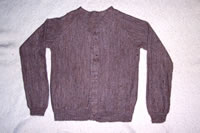 How To Make a V-Neck Cardigan Band With Buttonholes
How To Make a V-Neck Cardigan Band With Buttonholes
Under construction! For more lessons, patterns etc. visit my blog. Look for "generators", or read the various articles. I made the button band for Jim's Sideways Knit Cardigan using Roz Porter's method, which I discuss in general here. The pattern generator for Jim's sweater automatically calculates the placement on that sweater. You don't need to measure. However, if you knit someone else's pattern, and want to add this button band, this page will tell you how to place the buttonholes and provide links to a how to knit button holes lesson.
This page is adapted with permission from Roz Porter's 1996 newsletter. (Thank you Roz!)
I modified Roz's text to adjust for the fact that the generator on the page automatically calculates the number or rows and stitches for a button band for your cardigan. I also added a minor extension so; you can adjust the width of the band (assuming you want to do that.) To learn how to actually knit an individual button band, you will need to read my article "Roz buttonholes" which I published at my blog or Roz's original article.
Good luck!
Lucia
PS. If you are shopping for good prices on knitting machines or parts, AllBrands.com